Paul Bishop's Blog, page 42
August 24, 2015
THE TRUTH IS COMING
Published on August 24, 2015 21:29
AVOIDING OBNOXIOUS PROMOTION
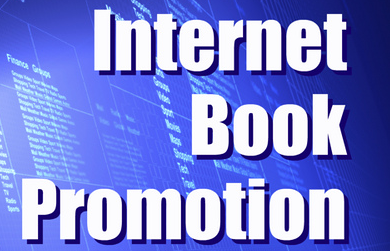 AVOIDING OBNOXIOUS PROMOTION PAUL BISHOP Most of us have had to unfriendor block individuals on our social networking sites whose excessive self-promotion constantly clutters up newsfeeds and group pages. These cretins have no idea how obnoxious they are and never contribute anything but self-promotion to the groups they are, in essence, spamming. They are not selling sunglasses nobody wants or shady diet programs, but they are inflexibly on the same spiked slide to hell. Incessant promo saturation of social networks can turn a writer into their own worst enemy. This type of behavior is the drastic end of the promotion Bell Curve. Most independent writers use social media as a platform to engage potential readers, but generally manage to avoid repellant oversaturation. Still, the tipping point of too much self-promotion via social networking remains a speedbump any of us can stumbled over. There are three rules for writing a novel. Unfortunately, no one knows what they are ~ W. Somerset Maugham. This oft quoted axiom can be slightly twisted and applied to promotion – There are three rules to successful book promotion. Unfortunately, no one knows what they are. While this may be true, there is still a more spot on Murphy’s Law style connection applicable to promotion – The more relentless the promotion, the less the worth of the promoted product. We’ve all been battered by an overly pushy author’s promotion. Finally, against our better judgement, we relent and download a sample from Amazon. But we are hardly surprised when we find the relentlessly promoted novel is dreck of the first order. Most often it hardly qualifies as writing, let alone storytelling. A chimp using a crayon on butcher paper could turn out a more entertaining yarn. Usually, our first clue to this pending disaster pops up if we take the time to read the product description of the novel on the Amazon page. If it’s full of typos, sentences fragments, and claims of The Greatest Novel Ever Written, trouble is definitely on the horizon. And if there are a whole gaggle of scattered exclamation points and no commas, the sirens are sounding and the ship is going down fast!!! Admit it, we’ve all experience this phenomenon. All you can do is shake your head and perhaps learn a little something about what not to do. Self-promoters are constantly being reminded that the key to social networking is participation, contribution, and engagement. If everything you post and tweet is promotion, your message is going to be ignored at best, and blocked or reported at worst. Despite this constant warning, there are those who feel they don’t have the time, or are too important, to contribute or engage. They can even believe this type of social network interaction is beneath them – after all they are an important author. All of us know an individual who falls into this category. If you don’t, then you’re probably the one guilty of committing the violations. Do you believe the world is just waiting for your magnum opus to be released? Do you believe the movie rights to your short story can’t fail to be snapped up? Is bestseller status just a click or two away? If so, you’re going to be upset and bad tempered when your glorious dreams of being a feted author lie in rubble around your ten-year-old computer screen in your mother’s basement. Like many of my peers, I rely on social networks to spread the word about my current publications. Not wanting to estrange friends or fans, I try to keep to a ratio of at least 10 engagement/contribution posts to 1 strictly promotional announcement – and then only when I have something new to promote. I may do a little higher ratio of promo on my author page where it is expected, but I still make a point of promoting the works of others more than mine. I rarely post more than one personal promo a day unless I'm building up to a new release (like now), and I try to change up the graphics and text of my posts as much as possible. It's still repetitive, but hopefully not too obnoxious. Unless a social network group is promo specific, I try to judge the make-up of a group and decided not only how much promo I should do, but if I should do any at all. Some of the groups I participate in on Facebook, which focus on specific interests or topics such as vintage, noir, or movies, are not a good target market for my latest cop novel. There may be a couple of members I might contact privately, but they are usually already on the feed from my author page. However, if I'm a regular participant and contributor to a group not related to new books – for instance the Men's Adventure Magazines group on Facebook – I'll ask the moderator's permission to drop the occasional off topic promo. Simply plastering your unrelated promo to an unrelated group is the fastest way to get blocked and tossed. However, if the group moderator buys in to your promo, they will often comment on it and support it – which works a lot better. I belong to a number of law enforcement related groups. Some of these are hardcore police training, SWAT, or strictly investigative related – you know, serious stuff. These are groups where promo of my new novel – even though it’s a cop novel – would most likely fall with a clang. But there are other, socially oriented police groups, where I feel comfortable sharing my news. Even then, I limit my promo to once a week and always mention my connection to law enforcement. The other thing to consider is how many of your FB friends or Twitter followers belong to the same groups or feeds as you do. If they are seeing your promos over and over in every group you have in common, you aren’t reaching new eyes and are just hitting your regulars over the head. To help spread the word, I rely on related groups not frequented by those I usually a hangout with in the virtual world. The amount of promotion you can get away with can sometimes depend on how prolific you are. Are you regularly promoting new works – in new ways – or are you rehashing the same book, the same way, over and over ad nauseaum? Here’s the rub – incessant, repetitive, promo does more harm than good, but if you don’t do enough promotion, everyone forgets your work exists and it stops selling. This is a high wire act. If you fall, you are risking a nasty backlash instead of a profitable uptick. The best rule of thumb regarding promotion I’ve ever been offered is simple…Don’t be a dick. If your promotion becomes one of those erections you’ve been warned about lasting three hours or more, you need to back off your prescription to the little blue pill.
AVOIDING OBNOXIOUS PROMOTION PAUL BISHOP Most of us have had to unfriendor block individuals on our social networking sites whose excessive self-promotion constantly clutters up newsfeeds and group pages. These cretins have no idea how obnoxious they are and never contribute anything but self-promotion to the groups they are, in essence, spamming. They are not selling sunglasses nobody wants or shady diet programs, but they are inflexibly on the same spiked slide to hell. Incessant promo saturation of social networks can turn a writer into their own worst enemy. This type of behavior is the drastic end of the promotion Bell Curve. Most independent writers use social media as a platform to engage potential readers, but generally manage to avoid repellant oversaturation. Still, the tipping point of too much self-promotion via social networking remains a speedbump any of us can stumbled over. There are three rules for writing a novel. Unfortunately, no one knows what they are ~ W. Somerset Maugham. This oft quoted axiom can be slightly twisted and applied to promotion – There are three rules to successful book promotion. Unfortunately, no one knows what they are. While this may be true, there is still a more spot on Murphy’s Law style connection applicable to promotion – The more relentless the promotion, the less the worth of the promoted product. We’ve all been battered by an overly pushy author’s promotion. Finally, against our better judgement, we relent and download a sample from Amazon. But we are hardly surprised when we find the relentlessly promoted novel is dreck of the first order. Most often it hardly qualifies as writing, let alone storytelling. A chimp using a crayon on butcher paper could turn out a more entertaining yarn. Usually, our first clue to this pending disaster pops up if we take the time to read the product description of the novel on the Amazon page. If it’s full of typos, sentences fragments, and claims of The Greatest Novel Ever Written, trouble is definitely on the horizon. And if there are a whole gaggle of scattered exclamation points and no commas, the sirens are sounding and the ship is going down fast!!! Admit it, we’ve all experience this phenomenon. All you can do is shake your head and perhaps learn a little something about what not to do. Self-promoters are constantly being reminded that the key to social networking is participation, contribution, and engagement. If everything you post and tweet is promotion, your message is going to be ignored at best, and blocked or reported at worst. Despite this constant warning, there are those who feel they don’t have the time, or are too important, to contribute or engage. They can even believe this type of social network interaction is beneath them – after all they are an important author. All of us know an individual who falls into this category. If you don’t, then you’re probably the one guilty of committing the violations. Do you believe the world is just waiting for your magnum opus to be released? Do you believe the movie rights to your short story can’t fail to be snapped up? Is bestseller status just a click or two away? If so, you’re going to be upset and bad tempered when your glorious dreams of being a feted author lie in rubble around your ten-year-old computer screen in your mother’s basement. Like many of my peers, I rely on social networks to spread the word about my current publications. Not wanting to estrange friends or fans, I try to keep to a ratio of at least 10 engagement/contribution posts to 1 strictly promotional announcement – and then only when I have something new to promote. I may do a little higher ratio of promo on my author page where it is expected, but I still make a point of promoting the works of others more than mine. I rarely post more than one personal promo a day unless I'm building up to a new release (like now), and I try to change up the graphics and text of my posts as much as possible. It's still repetitive, but hopefully not too obnoxious. Unless a social network group is promo specific, I try to judge the make-up of a group and decided not only how much promo I should do, but if I should do any at all. Some of the groups I participate in on Facebook, which focus on specific interests or topics such as vintage, noir, or movies, are not a good target market for my latest cop novel. There may be a couple of members I might contact privately, but they are usually already on the feed from my author page. However, if I'm a regular participant and contributor to a group not related to new books – for instance the Men's Adventure Magazines group on Facebook – I'll ask the moderator's permission to drop the occasional off topic promo. Simply plastering your unrelated promo to an unrelated group is the fastest way to get blocked and tossed. However, if the group moderator buys in to your promo, they will often comment on it and support it – which works a lot better. I belong to a number of law enforcement related groups. Some of these are hardcore police training, SWAT, or strictly investigative related – you know, serious stuff. These are groups where promo of my new novel – even though it’s a cop novel – would most likely fall with a clang. But there are other, socially oriented police groups, where I feel comfortable sharing my news. Even then, I limit my promo to once a week and always mention my connection to law enforcement. The other thing to consider is how many of your FB friends or Twitter followers belong to the same groups or feeds as you do. If they are seeing your promos over and over in every group you have in common, you aren’t reaching new eyes and are just hitting your regulars over the head. To help spread the word, I rely on related groups not frequented by those I usually a hangout with in the virtual world. The amount of promotion you can get away with can sometimes depend on how prolific you are. Are you regularly promoting new works – in new ways – or are you rehashing the same book, the same way, over and over ad nauseaum? Here’s the rub – incessant, repetitive, promo does more harm than good, but if you don’t do enough promotion, everyone forgets your work exists and it stops selling. This is a high wire act. If you fall, you are risking a nasty backlash instead of a profitable uptick. The best rule of thumb regarding promotion I’ve ever been offered is simple…Don’t be a dick. If your promotion becomes one of those erections you’ve been warned about lasting three hours or more, you need to back off your prescription to the little blue pill.
 Novelist, screenwriter, and television personality, Paul Bishop spent 35 years with the Los Angeles Police Department, where he was twice honored as Detective of the Year. He continues to work privately as a deception expert. His fifteen novels include five in his LAPD Homicide Detective Fey Croaker series. His latest novel, Lie Catchers, begins a new series featuring top LAPD interrogators Ray Pagan and Calamity Jane Randall.
Novelist, screenwriter, and television personality, Paul Bishop spent 35 years with the Los Angeles Police Department, where he was twice honored as Detective of the Year. He continues to work privately as a deception expert. His fifteen novels include five in his LAPD Homicide Detective Fey Croaker series. His latest novel, Lie Catchers, begins a new series featuring top LAPD interrogators Ray Pagan and Calamity Jane Randall.www.paulbishopbooks.com ,
Twitter @bishsbeat ,
Facebook ,
Amazon
Published on August 24, 2015 17:29
August 23, 2015
THE TRUTH IS COMING...

“Paul Bishop is the real deal – real cop, real writer. You never go wrong with a Bishop novel.” – Max Allan Collins, author of Road to Perdition and the bestselling Nate Heller novels
THE TRUTH IS COMING...
Paul Bishop's LIE CATCHERS debuts this week from Pro Se Productions...
Cover by Jeffrey Hayes
Published on August 23, 2015 19:03
August 22, 2015
CARE AND FEEDING OF AMAZON AUTHORS
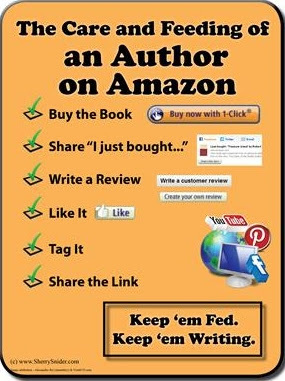 I recently discovered the blog of technical writer Sherry Snider. It contains a wealth of information on any number of how to subjects near and dear to the heart of independent authors. With her permission, I have reprinted below her second article on The Care and Feeding of an Author on Amazon. This is a great step by step listing of how fans and readers can help an author via Amazon. These steps appear simple, but sometimes you have to spell it out for folks. As Sherry said to me in a IM exchange, “Funny thing is, when I originally published the post, some authors actually took umbrage at the idea of authors asking their readers to post reviews or to help in any way. Now, it's common practice to politely ask readers for support. My, things do change quickly.”
I recently discovered the blog of technical writer Sherry Snider. It contains a wealth of information on any number of how to subjects near and dear to the heart of independent authors. With her permission, I have reprinted below her second article on The Care and Feeding of an Author on Amazon. This is a great step by step listing of how fans and readers can help an author via Amazon. These steps appear simple, but sometimes you have to spell it out for folks. As Sherry said to me in a IM exchange, “Funny thing is, when I originally published the post, some authors actually took umbrage at the idea of authors asking their readers to post reviews or to help in any way. Now, it's common practice to politely ask readers for support. My, things do change quickly.” THE CARE AND FEEDING OF AN AUTHOR ON AMAZON SHERRY SNIDER
[My first blog post on the subject] seemed to help a lot of authors and friends of authors, so here’s the next installment, The Care and Feeding of an Author on Amazon. The infographic is literally, a checklist of things folks can do on Amazon to help an author. Detailed instructions and screenshots for each item are included in the post below.
Other online retailers have similar features, but Amazon is the reigning champ of online sales. Using these features helps the author and the specific book(s) gain visibility…which increases the likelihood of sales. Again, we want to keep authors fed, watered, and writing, right?
BUY

Duh. Of course, BUYING an author’s book or e-book helps directly. It not only puts money in the author’s pocket, it also boosts sales figures. The more a book sells, the more love it will get from the book store (Amazon).
SHARE I JUST BOUGHT...
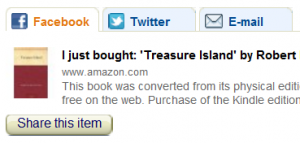 Click to share I just bought on Amazon on social networks.
Click to share I just bought on Amazon on social networks.When you purchase a book or e-book on Amazon, you’ll get an option to share news of your purchase on social media. That DOES add clout to the share. People DO tend to notice if a friend actually pays for a book AND makes the effort to share.
You even get this option if you purchase an e-book during a free promotion. The post doesn’t share how much you spent…just that you got it. Sharing the I Just Bought info on your social network spreads your endorsement and support even further than just the purchase.
WRITE A REVIEW
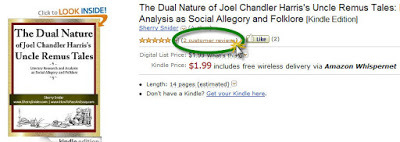 This is HUGE! We all read reviews before we buy (usually), and reviews on books are especially important. We all read a bit differently depending on our personal experiences, so book reviews are relatively subjective. Heck, bad reviews influence our buying decisions just as much as good reviews. Either way, a large number of reviews is always helpful.
This is HUGE! We all read reviews before we buy (usually), and reviews on books are especially important. We all read a bit differently depending on our personal experiences, so book reviews are relatively subjective. Heck, bad reviews influence our buying decisions just as much as good reviews. Either way, a large number of reviews is always helpful.It doesn’t have to be a long analysis. I think the current minimum for an Amazon review is 20 words. 20 words. That’s like a substantial tweet. You can do that to support an author, right?
To write a review, open the book or e-book’s listing on Amazon. Near the top, you can use the existing reviews link as a shortcut, or you can scroll down to the reviews listed lower on the page. If it’s a new book, you might see a link to be the first to review this book.
 Click the Write a Customer Review button or the Create Your Own Reviewbutton.
Click the Write a Customer Review button or the Create Your Own Reviewbutton. Writing a review only takes a few quick answers to questions on a form. If you’re not already logged in to your Amazon account, you’ll be prompted to do so before you submit a review.
Writing a review only takes a few quick answers to questions on a form. If you’re not already logged in to your Amazon account, you’ll be prompted to do so before you submit a review.You rate the book with 1-5 stars with 5 stars indicating you loved it. If you hover over each star, pop up text will describe how Amazon perceives the rating – loved it, hated it, etc.
You enter a title for your review – usually something positive or negative that summarizes how you feel about the book, like Great Beach Read, Really Helpful, or Waste of Time.
You type 20 words or more telling folks how you feel about the book, if you recommend it, to whom, and why.
Notice that’s under the default tab for a Written Review. There’s also a tab if you’d prefer to submit a video review of the book.
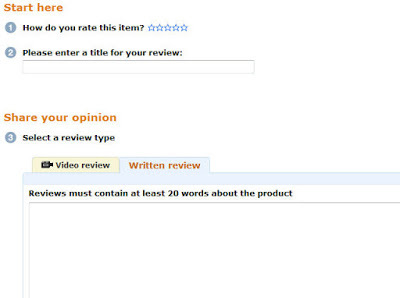 VIDEO REVIEWS
VIDEO REVIEWSYou actually don’t even have to WRITE a review for Amazon. You can submit a video review. Use your webcam or smartphone to record your thoughts on the book and upload it just like you’d submit a written review.
You can also post the same video review on YouTube. Make sure to use the book’s title, author name, and any keywords or terms associated with the book in the YouTube video’s title and description. YouTube is one of the most highly searched sites online. Your video review will get views.
Once you have your written or video review ready, click the Preview Your Review button to see what it’ll look like, then submit.
LIKE IT
 Yeah, I know. Likeis WAY overused on multiple social media sites, but Amazon uses it too – and it is a quick and easy way to show your author’s book a little Amazon love. Just click the Like button near the top of the book’s listing.
Yeah, I know. Likeis WAY overused on multiple social media sites, but Amazon uses it too – and it is a quick and easy way to show your author’s book a little Amazon love. Just click the Like button near the top of the book’s listing.SEND THE LINK
One last thing you can do while you’re still on Amazon is to grab the URL (link) for the book.
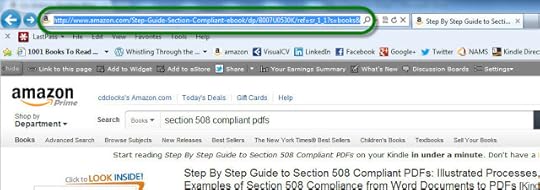 Select that http://www…line at the top of your web browser and copy it (right-click and select copy or press CTRL+C). Then you can paste the URL link in an email, on a social media site, etc. Word of mouth is awesome, but it’s much more convenient if your friends can just click on the link rather than remember and search for a title. Feel free to share with friends, too. A few clicks can go a long way toward keeping an author fed, watered, and writing.
Select that http://www…line at the top of your web browser and copy it (right-click and select copy or press CTRL+C). Then you can paste the URL link in an email, on a social media site, etc. Word of mouth is awesome, but it’s much more convenient if your friends can just click on the link rather than remember and search for a title. Feel free to share with friends, too. A few clicks can go a long way toward keeping an author fed, watered, and writing.
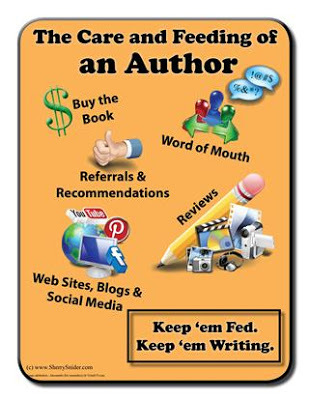 To download the printable Amazon-specific infographic
CLICK HERE
To download the printable Amazon-specific infographic
CLICK HERE
 ABOUT THE AUTHOR: Sherry Snider, Technical Writer evolved over years of teaching English, reading, and speech, then, working in the IT field. After documenting hundreds of technical processes and teaching others how to duplicate results, technical writing and training became the next logical career path. Sherry takes technical writing, multimedia, training, and consulting projects in a variety of industries. Though hardware (assembly, troubleshooting, repair, etc.) and software (user manuals, admin manuals, developers’ guides, etc.) are usually her favorite projects, pretty much any customer with cool toys and tech to master has a good chance of capturing her interest –especially if her specific experience and skills offer significant value to the project or customer/client. ON THE WEB
Website
Facebook
Twitter
ABOUT THE AUTHOR: Sherry Snider, Technical Writer evolved over years of teaching English, reading, and speech, then, working in the IT field. After documenting hundreds of technical processes and teaching others how to duplicate results, technical writing and training became the next logical career path. Sherry takes technical writing, multimedia, training, and consulting projects in a variety of industries. Though hardware (assembly, troubleshooting, repair, etc.) and software (user manuals, admin manuals, developers’ guides, etc.) are usually her favorite projects, pretty much any customer with cool toys and tech to master has a good chance of capturing her interest –especially if her specific experience and skills offer significant value to the project or customer/client. ON THE WEB
Website
Facebook
Twitter
Published on August 22, 2015 23:06
COMING THIS WEEK FROM PRO SE PRODUCTIONS
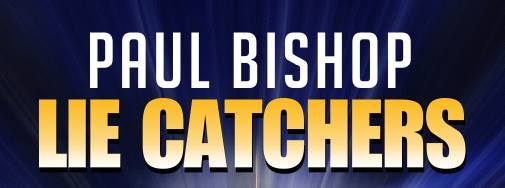 "Lie Catchers crackles with authenticity. Bishop's thirty-five years as an LAPD Top Cop fuels a turbo-charged novel.” ~ Robert Crais, bestselling author of the Elvis Cole novels.
"Lie Catchers crackles with authenticity. Bishop's thirty-five years as an LAPD Top Cop fuels a turbo-charged novel.” ~ Robert Crais, bestselling author of the Elvis Cole novels.NEW THIS WEEK FROM PRO SE PRODUCTIONS LIE CATCHERS
The First in a new series of mystery thrillers from noted author and retired LAPD Detective Paul Bishop (The Fey Croaker Series, Fight Card, the Walker/Tamino Mysteries) is coming from Pro Se!
Find out what the leading mystery authors of today are saying about Lie Catchers by staying tuned to the Pro Se Productions page all this week... CLICK HERE
When finding the truth literally means life or death, you need the LIE CATCHERS...
Published on August 22, 2015 10:44
MY FIRST NOVEL
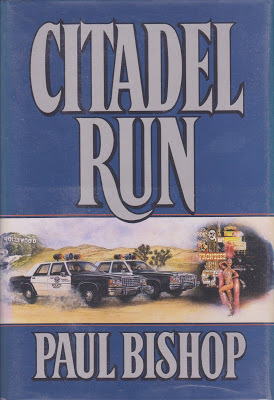 Ed Gorman has featured me on his blog with a ripping tale about writing my first novel, Citadel Run (a.k.a. Hot Pursuit in the current e-book version). With the pending publication of my latest cop novel, Lie Cathers, it was a little strange to go back and think about the process of beginning my writing career, but also somewhat cathartic...I've tipped in a little taste of the extensive blog post below with a link to the full article...
Ed Gorman has featured me on his blog with a ripping tale about writing my first novel, Citadel Run (a.k.a. Hot Pursuit in the current e-book version). With the pending publication of my latest cop novel, Lie Cathers, it was a little strange to go back and think about the process of beginning my writing career, but also somewhat cathartic...I've tipped in a little taste of the extensive blog post below with a link to the full article...MY FIRST NOVEL
Technically, my first novel was a title in the Diamondback series of adult westerns. Written under the house pseudonym Pike Bishop, the series of paperback originals was created by Raymond Obstfeld and published by Pinnacle. My entry was Diamondback #6: Shroud of Vengeance. It featured plenty of six-gun and sagebrush action built around the two required explicit sex scenes – the raison d’etre for the very existence of the successful adult western genre.
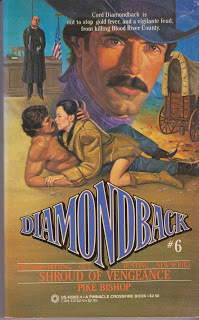 I would never disparage the genre or disavow my connection to it, but despite my gratitude to Ray Obstfeld for taking a chance on a novice, and the coolness of the Pike Bishop pseudonym echoing my name, I actually consider Citadel Run to be my first novel – I created the characters, the plot was uniquely mine, there were no required sex scenes to wedge in, and my real name was right there on the covers of both the hardback and the paperback.
I would never disparage the genre or disavow my connection to it, but despite my gratitude to Ray Obstfeld for taking a chance on a novice, and the coolness of the Pike Bishop pseudonym echoing my name, I actually consider Citadel Run to be my first novel – I created the characters, the plot was uniquely mine, there were no required sex scenes to wedge in, and my real name was right there on the covers of both the hardback and the paperback. To understand how Citadel Run evolved, I need to digress. In 1977, I joined the Los Angeles Police Department. As I moved from uniformed patrol to the detective squad, I still pursued my writing aspirations on the side. For most writers, life necessitates another career – one that pays the bills, provides health insurance, and has all the other perks of a real job.
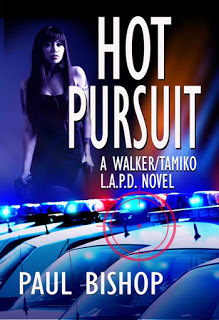 Still, I’ve always considered myself a very lucky guy being able juggle two careers and doing the work I enjoy – putting villains in jail and putting words on paper. One career is a lot more dangerous, but it is also a lot more financially secure. I spent thirty-five years with the LAPD. For thirty of those years, I also worked as a professional writer, completing twelve published novels, multiple hours of episodic television, and a produced feature film.
Still, I’ve always considered myself a very lucky guy being able juggle two careers and doing the work I enjoy – putting villains in jail and putting words on paper. One career is a lot more dangerous, but it is also a lot more financially secure. I spent thirty-five years with the LAPD. For thirty of those years, I also worked as a professional writer, completing twelve published novels, multiple hours of episodic television, and a produced feature film.Police and detective work often fed my creative muse, but there were also many times the creativity I honed as a writer led to a breakthrough in a case.
FOR THE FULL ARTICLE CLICK HERE
Published on August 22, 2015 09:53
BRIAN DRAKE: THE REWARDS OF SELF-PUBLISHING
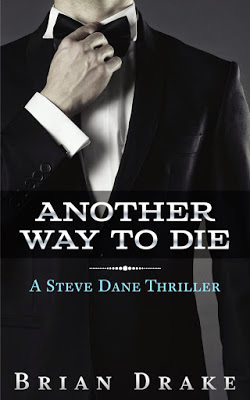 Brian Drake recently gave us his dollars-and-sense version of self-publishing. This time around, he takes a second look at the true rewards of self-publishing, which have nothing to do with money…
Brian Drake recently gave us his dollars-and-sense version of self-publishing. This time around, he takes a second look at the true rewards of self-publishing, which have nothing to do with money…THE REWARDS OF SELF-PUBLISHINGBRIAN DRAKE When we last spoke about the costs of self-publishing, even I had to admit what I described didn't look very good. But after that piece went to press, I started thinking. I may not have any large monetary reward for my DIY publishing efforts, but I have something a little more valuable – to me, anyway. I wanted to do this follow-up to show you that something similar can happen to you, too.
 I wouldn't be writing these articles for Paul if it hadn't been for my self-publishing, because that's how we met. He featured Justified Sins on his blog, made some nice remarks about Bullet for One on Amazon, and we then connected through Facebook. All of that was a prelude to his invitation to write a Fight Card story, which I did entitled Copper Mountain Champ (What? You missed it? It's a good one, check it out). Then there's James Reasoner. You should know who he is. When I started my blog back in 2010, he commented frequently, which was how we connected. He allowed me to do some guest posts on his blog to promote my books, and when he and Stephen Mertz (you should also know who he is) started the Blaze! western series, I sent James a note asking if I could audition. He told me to send my idea... and maybe. Well, he and Mertz liked my idea, and now I have a book due to them. It's also my first western. I've wanted to write a western for the longest time, and now I'll be edited by two writers who have been doing western since before I was born. You can't buy that kind of education. Let's go back to Paul for a moment. Paul knows a guy named Tommy Hancock, editor and publisher of Pro Se Productions. You should really know who he is. Together they created some fresh pulp characters for an anthology and invited writers to do the stories. Tommy invited me based on what Paul told him. Somehow, I guess, I hadn't embarrassed myself to much along the way. I was happy to write Never Enough Corpses for Pulse Fiction Vol. 1 (You missed that too? We really need to have a talk).
I wouldn't be writing these articles for Paul if it hadn't been for my self-publishing, because that's how we met. He featured Justified Sins on his blog, made some nice remarks about Bullet for One on Amazon, and we then connected through Facebook. All of that was a prelude to his invitation to write a Fight Card story, which I did entitled Copper Mountain Champ (What? You missed it? It's a good one, check it out). Then there's James Reasoner. You should know who he is. When I started my blog back in 2010, he commented frequently, which was how we connected. He allowed me to do some guest posts on his blog to promote my books, and when he and Stephen Mertz (you should also know who he is) started the Blaze! western series, I sent James a note asking if I could audition. He told me to send my idea... and maybe. Well, he and Mertz liked my idea, and now I have a book due to them. It's also my first western. I've wanted to write a western for the longest time, and now I'll be edited by two writers who have been doing western since before I was born. You can't buy that kind of education. Let's go back to Paul for a moment. Paul knows a guy named Tommy Hancock, editor and publisher of Pro Se Productions. You should really know who he is. Together they created some fresh pulp characters for an anthology and invited writers to do the stories. Tommy invited me based on what Paul told him. Somehow, I guess, I hadn't embarrassed myself to much along the way. I was happy to write Never Enough Corpses for Pulse Fiction Vol. 1 (You missed that too? We really need to have a talk).
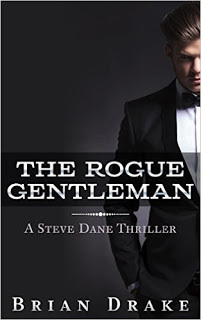 None of these connections would have happened without the calling cards of my self-publishing projects. Years ago, like every writer starting out, I couldn't get any attention with my work. What magazines still existed back in the '90s didn't want hard-boiled. The web and crime zines laughed at me. And Alfred Hitchcock's Mystery Magazine sent not only rejection letters, but eventually a restraining order – I framed it. After a few more years of typing quietly and not sending anything out, I decided to do it myself, and now I have all these new friends. What they've done is given a young writer (well, not so young anymore) what every young writer wants to hear – We think you're good enough to work with us. And Paul and James in particular know posers when they see them. Somehow I passed muster. Somehow you might, too. Once your work is out there, you never know who will see it. That's why it's important your writing be as professional as possible. Since getting a Kindle recently, I've gone crazy downloading free books, trying to find the hot new talent, and sampling some of the self-publishing heroes to see if I can learn anything from them. I've deleted nine out of ten books because the writing screams amateur – even those writers look at as heroes of self-publishing have problems. I once disagreed with Lee Goldberg and his Tsunami of Crap theory, but now I think he has a point.
None of these connections would have happened without the calling cards of my self-publishing projects. Years ago, like every writer starting out, I couldn't get any attention with my work. What magazines still existed back in the '90s didn't want hard-boiled. The web and crime zines laughed at me. And Alfred Hitchcock's Mystery Magazine sent not only rejection letters, but eventually a restraining order – I framed it. After a few more years of typing quietly and not sending anything out, I decided to do it myself, and now I have all these new friends. What they've done is given a young writer (well, not so young anymore) what every young writer wants to hear – We think you're good enough to work with us. And Paul and James in particular know posers when they see them. Somehow I passed muster. Somehow you might, too. Once your work is out there, you never know who will see it. That's why it's important your writing be as professional as possible. Since getting a Kindle recently, I've gone crazy downloading free books, trying to find the hot new talent, and sampling some of the self-publishing heroes to see if I can learn anything from them. I've deleted nine out of ten books because the writing screams amateur – even those writers look at as heroes of self-publishing have problems. I once disagreed with Lee Goldberg and his Tsunami of Crap theory, but now I think he has a point.
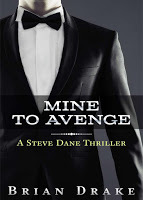 Everything I needed to learn, I learned from all the dead authors I’ve been reading for decades. This isn't amateur hour. If you're going to do this, you need to know your craft, and where commas go. Ignoring basic grammar out of some misguided attempt at style only makes you look like a fool, but somehow in our meme and text message centered world, the basics don’t matter. That’s the bright side to the not-so-pretty-picture I painted in my other article, and I hope you get something from it. Self-publishing is worth it, but you may find the rewards come in a different manner than you were expecting. And the Corvette is still for sale. ABOUT THE AUTHOR: Brian Drake lives in California and hopes to one day do an interview where all of his answers somehow incorporate Taylor Swift lyrics. You can reach him at briandrake88@yahoo.com/ ON THE WEBBRIAN DRAKE AT LARG
Everything I needed to learn, I learned from all the dead authors I’ve been reading for decades. This isn't amateur hour. If you're going to do this, you need to know your craft, and where commas go. Ignoring basic grammar out of some misguided attempt at style only makes you look like a fool, but somehow in our meme and text message centered world, the basics don’t matter. That’s the bright side to the not-so-pretty-picture I painted in my other article, and I hope you get something from it. Self-publishing is worth it, but you may find the rewards come in a different manner than you were expecting. And the Corvette is still for sale. ABOUT THE AUTHOR: Brian Drake lives in California and hopes to one day do an interview where all of his answers somehow incorporate Taylor Swift lyrics. You can reach him at briandrake88@yahoo.com/ ON THE WEBBRIAN DRAKE AT LARGAMAZON
Published on August 22, 2015 07:59
THE REWARDS OF SELF-PUBLISHING
 Brian Drake recently gave us his dollars-and-sense version of self-publishing. This time around, he takes a second look at the true rewards of self-publishing, which have nothing to do with money…
Brian Drake recently gave us his dollars-and-sense version of self-publishing. This time around, he takes a second look at the true rewards of self-publishing, which have nothing to do with money…THE REWARDS OF SELF-PUBLISHINGBRIAN DRAKE When we last spoke about the costs of self-publishing, even I had to admit what I described didn't look very good. But after that piece went to press, I started thinking. I may not have any large monetary reward for my DIY publishing efforts, but I have something a little more valuable – to me, anyway. I wanted to do this follow-up to show you that something similar can happen to you, too.
 I wouldn't be writing these articles for Paul if it hadn't been for my self-publishing, because that's how we met. He featured Justified Sins on his blog, made some nice remarks about Bullet for One on Amazon, and we then connected through Facebook. All of that was a prelude to his invitation to write a Fight Card story, which I did entitled Copper Mountain Champ (What? You missed it? It's a good one, check it out). Then there's James Reasoner. You should know who he is. When I started my blog back in 2010, he commented frequently, which was how we connected. He allowed me to do some guest posts on his blog to promote my books, and when he and Stephen Mertz (you should also know who he is) started the Blaze! western series, I sent James a note asking if I could audition. He told me to send my idea... and maybe. Well, he and Mertz liked my idea, and now I have a book due to them. It's also my first western. I've wanted to write a western for the longest time, and now I'll be edited by two writers who have been doing western since before I was born. You can't buy that kind of education. Let's go back to Paul for a moment. Paul knows a guy named Tommy Hancock, editor and publisher of Pro Se Productions. You should really know who he is. Together they created some fresh pulp characters for an anthology and invited writers to do the stories. Tommy invited me based on what Paul told him. Somehow, I guess, I hadn't embarrassed myself to much along the way. I was happy to write Never Enough Corpses for Pulse Fiction Vol. 1 (You missed that too? We really need to have a talk).
I wouldn't be writing these articles for Paul if it hadn't been for my self-publishing, because that's how we met. He featured Justified Sins on his blog, made some nice remarks about Bullet for One on Amazon, and we then connected through Facebook. All of that was a prelude to his invitation to write a Fight Card story, which I did entitled Copper Mountain Champ (What? You missed it? It's a good one, check it out). Then there's James Reasoner. You should know who he is. When I started my blog back in 2010, he commented frequently, which was how we connected. He allowed me to do some guest posts on his blog to promote my books, and when he and Stephen Mertz (you should also know who he is) started the Blaze! western series, I sent James a note asking if I could audition. He told me to send my idea... and maybe. Well, he and Mertz liked my idea, and now I have a book due to them. It's also my first western. I've wanted to write a western for the longest time, and now I'll be edited by two writers who have been doing western since before I was born. You can't buy that kind of education. Let's go back to Paul for a moment. Paul knows a guy named Tommy Hancock, editor and publisher of Pro Se Productions. You should really know who he is. Together they created some fresh pulp characters for an anthology and invited writers to do the stories. Tommy invited me based on what Paul told him. Somehow, I guess, I hadn't embarrassed myself to much along the way. I was happy to write Never Enough Corpses for Pulse Fiction Vol. 1 (You missed that too? We really need to have a talk).
 None of these connections would have happened without the calling cards of my self-publishing projects. Years ago, like every writer starting out, I couldn't get any attention with my work. What magazines still existed back in the '90s didn't want hard-boiled. The web and crime zines laughed at me. And Alfred Hitchcock's Mystery Magazine sent not only rejection letters, but eventually a restraining order – I framed it. After a few more years of typing quietly and not sending anything out, I decided to do it myself, and now I have all these new friends. What they've done is given a young writer (well, not so young anymore) what every young writer wants to hear – We think you're good enough to work with us. And Paul and James in particular know posers when they see them. Somehow I passed muster. Somehow you might, too. Once your work is out there, you never know who will see it. That's why it's important your writing be as professional as possible. Since getting a Kindle recently, I've gone crazy downloading free books, trying to find the hot new talent, and sampling some of the self-publishing heroes to see if I can learn anything from them. I've deleted nine out of ten books because the writing screams amateur – even those writers look at as heroes of self-publishing have problems. I once disagreed with Lee Goldberg and his Tsunami of Crap theory, but now I think he has a point.
None of these connections would have happened without the calling cards of my self-publishing projects. Years ago, like every writer starting out, I couldn't get any attention with my work. What magazines still existed back in the '90s didn't want hard-boiled. The web and crime zines laughed at me. And Alfred Hitchcock's Mystery Magazine sent not only rejection letters, but eventually a restraining order – I framed it. After a few more years of typing quietly and not sending anything out, I decided to do it myself, and now I have all these new friends. What they've done is given a young writer (well, not so young anymore) what every young writer wants to hear – We think you're good enough to work with us. And Paul and James in particular know posers when they see them. Somehow I passed muster. Somehow you might, too. Once your work is out there, you never know who will see it. That's why it's important your writing be as professional as possible. Since getting a Kindle recently, I've gone crazy downloading free books, trying to find the hot new talent, and sampling some of the self-publishing heroes to see if I can learn anything from them. I've deleted nine out of ten books because the writing screams amateur – even those writers look at as heroes of self-publishing have problems. I once disagreed with Lee Goldberg and his Tsunami of Crap theory, but now I think he has a point.
 Everything I needed to learn, I learned from all the dead authors I’ve been reading for decades. This isn't amateur hour. If you're going to do this, you need to know your craft, and where commas go. Ignoring basic grammar out of some misguided attempt at style only makes you look like a fool, but somehow in our meme and text message centered world, the basics don’t matter. That’s the bright side to the not-so-pretty-picture I painted in my other article, and I hope you get something from it. Self-publishing is worth it, but you may find the rewards come in a different manner than you were expecting. And the Corvette is still for sale. ABOUT THE AUTHOR: Brian Drake wasted his first forty years as a matter of course and principle. He has wandered all over California, been a broadcaster, newspaper reporter, and a salesman. He likes fast cars, peanut butter, Coke, cigars, red meat and whatever whiskey you got. ON THE WEBBrian Drake At Large
Everything I needed to learn, I learned from all the dead authors I’ve been reading for decades. This isn't amateur hour. If you're going to do this, you need to know your craft, and where commas go. Ignoring basic grammar out of some misguided attempt at style only makes you look like a fool, but somehow in our meme and text message centered world, the basics don’t matter. That’s the bright side to the not-so-pretty-picture I painted in my other article, and I hope you get something from it. Self-publishing is worth it, but you may find the rewards come in a different manner than you were expecting. And the Corvette is still for sale. ABOUT THE AUTHOR: Brian Drake wasted his first forty years as a matter of course and principle. He has wandered all over California, been a broadcaster, newspaper reporter, and a salesman. He likes fast cars, peanut butter, Coke, cigars, red meat and whatever whiskey you got. ON THE WEBBrian Drake At LargeAmazon
Published on August 22, 2015 07:59
August 21, 2015
THE 'LOW' COST OF SELF-PUBLISHING
 Recently, guest blogger Brian Drake gave us his take on The Cost of Self-Publishing. Brian will be back shortly with another side to the coin, but successful self-publisher Perry Constantine has also weighed in on the subject, which is presented below…
Recently, guest blogger Brian Drake gave us his take on The Cost of Self-Publishing. Brian will be back shortly with another side to the coin, but successful self-publisher Perry Constantine has also weighed in on the subject, which is presented below… THE LOW COST OF SELF-PUBLISHINGPERCIVAL CONSTANTINE Recently, I read a post by Brian Drake about The Cost of Self-Publishing. It was an interesting take on the subject and Brian makes some good points about the hidden costs of self-publishing that may not be readily apparent. However, after reading the post, I thought on my own self-publishing career. Before I go into too much detail on this, allow me to take a minute to tell you about my output to date in 2015. In January, I launched my Vanguard serial. Five episodes released a month apart, with a bonus prequel episode offered as an incentive for mailing list subscribers. June saw the release of Curse of the Necronomicon, the third novella in The Myth Hunter series, followed by the release of my third Infernum novella, Gentleman Rogue. The compilation of the first season of Vanguard will be out shortly followed by the debut of season two in September (with a switch to a bi-weekly schedule).
THE LOW COST OF SELF-PUBLISHINGPERCIVAL CONSTANTINE Recently, I read a post by Brian Drake about The Cost of Self-Publishing. It was an interesting take on the subject and Brian makes some good points about the hidden costs of self-publishing that may not be readily apparent. However, after reading the post, I thought on my own self-publishing career. Before I go into too much detail on this, allow me to take a minute to tell you about my output to date in 2015. In January, I launched my Vanguard serial. Five episodes released a month apart, with a bonus prequel episode offered as an incentive for mailing list subscribers. June saw the release of Curse of the Necronomicon, the third novella in The Myth Hunter series, followed by the release of my third Infernum novella, Gentleman Rogue. The compilation of the first season of Vanguard will be out shortly followed by the debut of season two in September (with a switch to a bi-weekly schedule).
 The reason I tell you all this is because at the costs Brian cites in his post, I would not be able to put out so many titles. Instead of monthly releases, I would be lucky if I could afford one annual release. But I’m able to put them out at professional quality for a fraction of the costs. Of course, it’s not easy. It takes a lot of hard work. And I will say first that my situation is somewhat unique. But the reason I’m able to put out so much work on my own is because I learned how to use the tools of the trade and learned how to use them well. I also paid attention to what was around me. It wasn’t always the case and there was some trial and error. The covers on my first three books—Fallen, Chasing The Dragon, and Love & Bullets were all truly, truly awful. The cover for Outlaw Blues was also not much better. The Lost Continent and Dragon Kings of the Orient fared much better, but they had another problem—there was no real series branding or sense of genre in them. A good cover designer will cost you a lot of money, but there are workarounds. I learned how to use Photoshop through a lot of practice. I researched tutorials on different effects, practiced those tutorials until they were committed to memory, and would always be on the lookout for more. I made friends with graphic designers and showed them my work and asked them to critique it. Those critiques are what led to the most-recent covers, seen below in these images:
The reason I tell you all this is because at the costs Brian cites in his post, I would not be able to put out so many titles. Instead of monthly releases, I would be lucky if I could afford one annual release. But I’m able to put them out at professional quality for a fraction of the costs. Of course, it’s not easy. It takes a lot of hard work. And I will say first that my situation is somewhat unique. But the reason I’m able to put out so much work on my own is because I learned how to use the tools of the trade and learned how to use them well. I also paid attention to what was around me. It wasn’t always the case and there was some trial and error. The covers on my first three books—Fallen, Chasing The Dragon, and Love & Bullets were all truly, truly awful. The cover for Outlaw Blues was also not much better. The Lost Continent and Dragon Kings of the Orient fared much better, but they had another problem—there was no real series branding or sense of genre in them. A good cover designer will cost you a lot of money, but there are workarounds. I learned how to use Photoshop through a lot of practice. I researched tutorials on different effects, practiced those tutorials until they were committed to memory, and would always be on the lookout for more. I made friends with graphic designers and showed them my work and asked them to critique it. Those critiques are what led to the most-recent covers, seen below in these images:
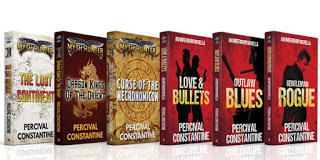
 All those covers were created by myself, using a combination of stock photography and Photoshop tutorials. I made them by studying the successful books in the genres I was targeting, and from there it took a lot of trial and error and a lot of critiquing from professional cover designers. Of course, I’m not saying this is by any means easy. But the total cost of all these covers combined was about $100 worth of stock photography. If you’re good with Photoshop, then it’s just a matter of studying the genres and seeing what works. Often times, you’d be surprised how effective a simple cover with strong branding can be. The Infernum covers, for example, are not at all complex. White background, dark figures, grunge overlay, color overlay, and text. But all those elements work together in a way that fits wonderfully into the thriller genre. But even if you don’t know the first thing about Photoshop and are unwilling to learn, there are still cheaper alternatives to an expensive cover. One option is
Canva
, an online resource for designing not only covers but also social media graphics. Another option is
DIY Book Covers
, a site launched by professional cover designer Derek Murphy. Fiverr has a number of people who will design covers or you can look at pre-made covers, which range in price from $30-50. Or make friends with people who are able to help out on covers. I’m part of an author group that has a great, active, and very supportive membership. The cover designers who critiqued my covers? They’re from that group. They’ve also done cover work for other members in the group, usually for nothing more than an exchange of services. For example, if one author can provide editing and another can provide covers, that can save you a lot of money. The cover’s taken care of, but there’s still the matter of formatting. Well, for about $30-40, you can purchase a copy of
Scrivener
. This is a wonderful all-in-one writing application. Not only is it a far superior word processor to Microsoft Word that gives you greater control in organizing your projects, but the compile features are tailor-made for the DIY self-publisher. Scrivener produces great ebooks in both epub and mobi formats with an auto-generated table of contents. There’s also an output for print books. I’ve never used this myself because I format my own books through Adobe InDesign. If you really insist on Word, then CreateSpace offers free templates for formatting paperbacks. Another epub formatting option is
Sigil
, a free cross-platform application for designing ebooks. Now there’s still the matter of editing, which is a big one. And this is something that can be harder to find good prices on. I have a benefit because I’ve worked as a professional editor and I have a masters degree in English and Creative Writing. I produce fairly clean manuscripts as first drafts and I’m able to catch about 98% of any additional mistakes on my editing passes. I also ask the people in my author groups to look over it, mostly for story problems. Again, this is where author groups are a valuable asset. Another option is just shop around. Look at the freelance sites like Elance or Upwork and post an ad with your budget. Maybe you’ll find someone, maybe you won’t. It’s worth trying. If this all sounds like it’s cutting corners, then you’d be right. But the wonderful thing about self-publishing, especially if you avoid paperbacks at first, is that nothing is set in stone. If you find a mistake, you can fix it and re-upload the file. If you can’t afford editing now but can in the future, then do what you can and go back to it later. You absolutely can break the bank with self-publishing, but it’s not true that this is the only way to do it properly. You just have to be smart about it and most importantly, do your research. For further information, I highly recommend
Bootstrapping For Indies: Self-Publishing on a Budget
by Simon Whistler. It’s a great book that will provide you with a lot more tips and advice on how to get your work out there on the cheap. The biggest expense I’ve found is advertising, but this is well worth it. There are some best practices to keep in mind with advertising in order to get the most out of your dollar. First of all, don’t promote the first book unless you have the second book out. Second, permafree does still work. I recently ran a promotion on Love & Bullets, the first book in my Infernum series. Love & Bullets is permafree and I bought ads from EReader News Today ($25) and BKnights on Fiverr ($5). The ad ran last month to tie in with the release of the third book in the series, Gentleman Rogue. Since the ad ran, I’ve seen something very interesting happen. Book two in the series, Outlaw Blues, has traditionally been one of my worst sellers. But after this ad, it’s become the top-selling title in my catalogue. I’ve also noticed many people buying not only Outlaw Blues but also Gentleman Rogue at the same time. If you don’t want to give it away for free, then try dropping the price of the first book to 99¢. And all of this is without being enrolled in Amazon’s Kindle Unlimited program. One thing Brian touched on which I’d like to mention are Facebook ads. This is an area that’s not very well understood and Facebook advertising is difficult to get a handle on. I haven’t tried them yet, but from what I understand, there are a few things you have to be very careful about. One is targeting. If the ads aren’t properly targeted to the right audience, you won’t get much of a return. Another is images. Make sure you use images that are ideally sized for the Facebook ads. And unless you’re trying to build up subscribers for your mailing list, you’re better off using Facebook advertising for high-priced items.
Mark Dawson
has provided a lot of valuable information about using Facebook advertising and I’d recommend signing up for his list and viewing his free videos on the subject. One of the things he recommends is not to advertise items that are under $5-6, because you need to move a lot more units in order to make money or even break even. If you’re an author of short titles that are priced primarily at $2.99, how can this be accomplished? Simple—bundles. Get out several books, bundle them together as a single ebook and publish it on the platforms. If you’re selling three $2.99 novels bundled together for $5.99, you’re basically running a “buy two, get one free” deal. While I haven’t been making a lot of money on self-publishing up until this point, I am building up more and more momentum month after month. I’ve been not only breaking even, but taking in a small profit. Not enough to quit my day job, but it is a start. ABOUT THE AUTHOR: Percival Constantine is an author, editor, book formatter, and cover designer who has been working in the publishing industry since 2005. He’s the author of several series: The Myth Hunter, Infernum, Vanguard, and Luther Cross.
All those covers were created by myself, using a combination of stock photography and Photoshop tutorials. I made them by studying the successful books in the genres I was targeting, and from there it took a lot of trial and error and a lot of critiquing from professional cover designers. Of course, I’m not saying this is by any means easy. But the total cost of all these covers combined was about $100 worth of stock photography. If you’re good with Photoshop, then it’s just a matter of studying the genres and seeing what works. Often times, you’d be surprised how effective a simple cover with strong branding can be. The Infernum covers, for example, are not at all complex. White background, dark figures, grunge overlay, color overlay, and text. But all those elements work together in a way that fits wonderfully into the thriller genre. But even if you don’t know the first thing about Photoshop and are unwilling to learn, there are still cheaper alternatives to an expensive cover. One option is
Canva
, an online resource for designing not only covers but also social media graphics. Another option is
DIY Book Covers
, a site launched by professional cover designer Derek Murphy. Fiverr has a number of people who will design covers or you can look at pre-made covers, which range in price from $30-50. Or make friends with people who are able to help out on covers. I’m part of an author group that has a great, active, and very supportive membership. The cover designers who critiqued my covers? They’re from that group. They’ve also done cover work for other members in the group, usually for nothing more than an exchange of services. For example, if one author can provide editing and another can provide covers, that can save you a lot of money. The cover’s taken care of, but there’s still the matter of formatting. Well, for about $30-40, you can purchase a copy of
Scrivener
. This is a wonderful all-in-one writing application. Not only is it a far superior word processor to Microsoft Word that gives you greater control in organizing your projects, but the compile features are tailor-made for the DIY self-publisher. Scrivener produces great ebooks in both epub and mobi formats with an auto-generated table of contents. There’s also an output for print books. I’ve never used this myself because I format my own books through Adobe InDesign. If you really insist on Word, then CreateSpace offers free templates for formatting paperbacks. Another epub formatting option is
Sigil
, a free cross-platform application for designing ebooks. Now there’s still the matter of editing, which is a big one. And this is something that can be harder to find good prices on. I have a benefit because I’ve worked as a professional editor and I have a masters degree in English and Creative Writing. I produce fairly clean manuscripts as first drafts and I’m able to catch about 98% of any additional mistakes on my editing passes. I also ask the people in my author groups to look over it, mostly for story problems. Again, this is where author groups are a valuable asset. Another option is just shop around. Look at the freelance sites like Elance or Upwork and post an ad with your budget. Maybe you’ll find someone, maybe you won’t. It’s worth trying. If this all sounds like it’s cutting corners, then you’d be right. But the wonderful thing about self-publishing, especially if you avoid paperbacks at first, is that nothing is set in stone. If you find a mistake, you can fix it and re-upload the file. If you can’t afford editing now but can in the future, then do what you can and go back to it later. You absolutely can break the bank with self-publishing, but it’s not true that this is the only way to do it properly. You just have to be smart about it and most importantly, do your research. For further information, I highly recommend
Bootstrapping For Indies: Self-Publishing on a Budget
by Simon Whistler. It’s a great book that will provide you with a lot more tips and advice on how to get your work out there on the cheap. The biggest expense I’ve found is advertising, but this is well worth it. There are some best practices to keep in mind with advertising in order to get the most out of your dollar. First of all, don’t promote the first book unless you have the second book out. Second, permafree does still work. I recently ran a promotion on Love & Bullets, the first book in my Infernum series. Love & Bullets is permafree and I bought ads from EReader News Today ($25) and BKnights on Fiverr ($5). The ad ran last month to tie in with the release of the third book in the series, Gentleman Rogue. Since the ad ran, I’ve seen something very interesting happen. Book two in the series, Outlaw Blues, has traditionally been one of my worst sellers. But after this ad, it’s become the top-selling title in my catalogue. I’ve also noticed many people buying not only Outlaw Blues but also Gentleman Rogue at the same time. If you don’t want to give it away for free, then try dropping the price of the first book to 99¢. And all of this is without being enrolled in Amazon’s Kindle Unlimited program. One thing Brian touched on which I’d like to mention are Facebook ads. This is an area that’s not very well understood and Facebook advertising is difficult to get a handle on. I haven’t tried them yet, but from what I understand, there are a few things you have to be very careful about. One is targeting. If the ads aren’t properly targeted to the right audience, you won’t get much of a return. Another is images. Make sure you use images that are ideally sized for the Facebook ads. And unless you’re trying to build up subscribers for your mailing list, you’re better off using Facebook advertising for high-priced items.
Mark Dawson
has provided a lot of valuable information about using Facebook advertising and I’d recommend signing up for his list and viewing his free videos on the subject. One of the things he recommends is not to advertise items that are under $5-6, because you need to move a lot more units in order to make money or even break even. If you’re an author of short titles that are priced primarily at $2.99, how can this be accomplished? Simple—bundles. Get out several books, bundle them together as a single ebook and publish it on the platforms. If you’re selling three $2.99 novels bundled together for $5.99, you’re basically running a “buy two, get one free” deal. While I haven’t been making a lot of money on self-publishing up until this point, I am building up more and more momentum month after month. I’ve been not only breaking even, but taking in a small profit. Not enough to quit my day job, but it is a start. ABOUT THE AUTHOR: Percival Constantine is an author, editor, book formatter, and cover designer who has been working in the publishing industry since 2005. He’s the author of several series: The Myth Hunter, Infernum, Vanguard, and Luther Cross. ONE THE WEB
PercivalConstantine.com
Twitter: @perconstantine
Facebook: Percival Constantine
Published on August 21, 2015 11:48
WHO'S IN YOUR CORNER?
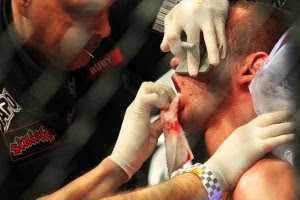 Thanks to Shawn Coyne for his permission to reprint a recent column he wrote for the
What It Takes
blog...
Thanks to Shawn Coyne for his permission to reprint a recent column he wrote for the
What It Takes
blog...
 THE THIRD MANSHAWN COYNEAfter each three minute round, the boxer gets a one-minute break.
THE THIRD MANSHAWN COYNEAfter each three minute round, the boxer gets a one-minute break.Tough Love.
He collapses onto a stool.
His cornerman squeezes water into his mouth and places a bucket beneath his jaw to catch the run-off. He then towels him off with an aggressive rub down to keep the muscles elastic.
All the while a second man, the fighter’s trainer peppers him with advice.
Stay out of the corners! Body blow, body blow, uppercut!
For the fighter, these two support systems are critical.
But they are not indispensable.
The third man in the corner is.
He doesn’t speak or concern himself with the boxer’s comfort. He just does what it takes to get the fighter ready to answer the next bell.
If the temple is swollen, he applies firm – but not too firm – pressure with a frosty enswell to the bruises. The goal is to reduce the puff without spreading the damage to other blood vessels. Too hard a push defeats its own purpose.
If there is bleeding, he cleans up the area with a cold towel. And then he dips extra thick, single-ended, Q-tip like, cotton swabs – like the ones they use in Emergency Rooms – into liquid adrenaline and jams the fibers into the cut, revealing as much of the damage as possible. Exposing the largest possible surface requires a certain brutality. If the fighter doesn’t wince and pull away, he hasn’t probed hard enough.
The adrenaline dams up the blood flow long enough for him to rub Avitene flour directly into the length and breadth of the laceration. The powder binds to the ends of the broken blood vessels and coagulates the flow. An eye socket seconds ago drenched by a red river is now as dry as Los Angeles. All with fifteen seconds to spare. Just enough time for the boxer to shake off the sting, compose himself, and lift himself off the stool. While the internal fight isn’t as wonderfully dramatic as an external bout, you still need three forces in your corner. You need a cornerman…the one to care for your basic needs…the inner gofer who makes sure you have your coffee, your chair, your desk at the appointed hour each and every day. You need a trainer…the one to teach you the craft, to remind you of the fundamentals when you make a mistake…your inner editor. But without a cutman…the one whose only purpose is to do whatever it takes to get you back in that ring…you’re lost.
 SHAWN COYNE ~ AUTHOR OF THE STORY GRID
www.thestorygrid.com
www.stevenpressfield.com
SHAWN COYNE ~ AUTHOR OF THE STORY GRID
www.thestorygrid.com
www.stevenpressfield.com
Published on August 21, 2015 09:31




